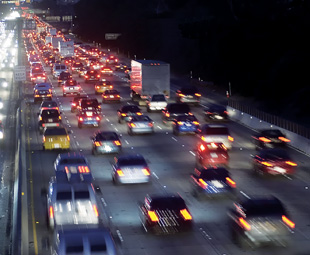Congestion threatens EU transport

Forget climate change – Europe’s commercial transporters cite chronic traffic congestion as their greatest challenge right now. FOCUS investigates.
The ongoing efforts of both policy-makers and commercial vehicle OEMs in Europe to introduce ‘greener’ vehicles has held the global media spotlight for several years. Technologies to reduce harmful exhaust gas emissions from trucks and buses now garner more attention than groundbreaking vehicle safety systems, once the ‘poster children’ for leading European commercial vehicle manufacturers.
Speak to a European commercial transporter today, however, and you’ll find that while safety and environment do rank highly on corporate responsibility agendas, the everyday nightmare of traffic congestion is the most immediate threat to fleet sustainability in the union.
A world-leader in objective research, analysis and reporting on global economic and business issues, the Economist Intelligence Unit (the in-house research unit of The Economist), released an extensive report in 2010 titled ‘Keeping traffic flowing’, analysing how transport infrastructure, policies and technology can help to ensure efficient transport on a sustainable basis in the years to 2030. Sponsored by MAN, the report focuses on the mobility challenges facing EU nations as well as leading emerging economies, including South Africa.
From a business perspective in both the EU and developing nations, the report states that: “In the years to 2030, a number of significant risks are looming to the free movement of goods and people. While governments claim that ambitious infrastructure investment schemes will ameliorate congestion problems to 2030, the fact remains that congestion is growing, particularly in urban areas.
“A legacy of inadequate funding and poor planning in many countries has slowed mobility and, from the business perspective, at least, has cast doubts over whether transport efficiency will improve in the future. Chronic transport bottlenecks for goods and people threaten to slow long-term economic growth, and impose significant costs on individuals and businesses in the short and medium term.”
The report adds that developed economies such as Spain and the UK have undertaken investment programmes aimed at alleviating congestion, while France and Germany have prioritised high-speed mobility in their spending plans.
“Despite ambitious infrastructure investment plans in many countries,” adds the report, “only 27% of executives surveyed (for the report) say infrastructure in their countries is fully adequate. Nearly half (49%) of respondents say transport infrastructure shortfalls pose the greatest risk to their supply chains. Companies expect their congestion-related costs to keep rising. Survey respondents are pessimistic about near-term improvements in mobility.”
According to the report, the business costs associated with blocked traffic include lost time, wasted fuel, forgone business, and a need for increased inventories and storage space.
“Companies expect these costs to continue to rise. The cost of transport itself is also expected to increase. Both business and government officials expect users will pay higher road and rail charges in the decades ahead, to cover the costs of new infrastructure.
“Tighter environmental rules will further raise the cost of transport. The higher costs of both congestion and road/rail use will prompt companies to pay closer attention to transport and logistics when choosing operating sites,” continues the report.
In light of these obstacles, companies are “finding inventive ways to squeeze more out of existing infrastructure,” the report says, including the tightening of supply chains, co-ordinating shipments with suppliers/customers and increasing night-time deliveries.
“Logistics providers and road and rail operators are increasingly using IT systems to navigate around blockages and improve traffic flow,” the report adds. “Nearly two-thirds (63%) of respondents consider intelligent logistics systems to be most helpful in making the most of existing infrastructure. Companies are relying on information and communication technology (ICT) systems such as vehicle-to-hub or vehicle-to-vehicle data transfers or informatics-based traffic management systems to avoid transport logjams. Nearly one-half (47%) mention new IT systems allowing smarter vehicle navigation as among the most useful logistics network improvements.”
The report cites efficiency improvements in fuel consumption of up to 30% and enhancements in vehicle routing of up to 20% gained using transport management systems and allied communications technologies.
In conclusion, the report advises all transporters to meet the challenges posed by congestion and related infrastructure inefficiencies by tracking the true costs of transport (which includes hidden costs such as delays due to traffic congestion and border posts), prioritising logistics as a mission-critical function within the organisation (via strategic alignment of skills and third party suppliers), and adopting “green” practices including making fleets more fuel-efficient, adding alternative-fuel vehicles, using intelligent logistics systems to avoid traffic jams, and adopting technologies to ease freight transfers between road and other transport modes.
Published by
Focus on Transport
focusmagsa



